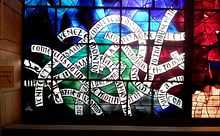Mordecai Ardon
| Mordecai Ardon מרדכי ארדון | |
|---|---|
 | |
| Born |
Max Bronstein[1] July 13, 1896[1] Tuchów, Galicia, Austria-Hungary[1] |
| Died |
June 18, 1992 (aged 95)[1] Jerusalem[1] |
| Nationality | Israeli |
| Awards | Israel Prize (1963) |
Mordecai Ardon (Hebrew: מרדכי ארדון, July 13, 1896 – June 18, 1992) was an Israeli painter.
Biography


Ardon was born Max Bronstein in 1896 in Tuchów, Galicia (then Austria-Hungary, now Poland). In 1933 he emigrated to Jerusalem in Mandate Palestine.[2] He was granted Palestinian citizenship in 1936 and changed his name to Mordecai Ardon.[1]
He participated in the Venice Biennale of 1968.
Beginning in the 1950s Ardon adopted a complex system of symbolic images in his paintings, taken from the Jewish Mystical tradition (Kabbalah), from the Bible and from a tangible reality. In his painting "Gates of Light", for example, he expressed "the inner mystery and timelessness of the landscape." His work seeks to impart a cosmic dimension to the present, linking it to antiquity and mystery. The same approach can be found in "At the Gates of Jerusalem" (1967), which shows the attempt to "convey his feelings about the cosmic significance of Israel’s return to the Old City of Jerusalem during the Six-Day War".[3] "Bird near a yellow wall" (1950) demonstrates his simplistic involvement with the Holocaust, a subject to which he was one of the few Israeli artists to devote a phase of his work, at that time.
As a teacher and director of the "New Bezalel", Ardon conveyed his sense of social involvement, his tendency towards Jewish mysticism and local mythology, and the combination of personal national symbols with reality-always stressing masterful technique. Pupils such as Avigdor Arikha, Yehuda Bacon, Naftali Bezem, Shraga Weil and Shmuel Boneh absorbed these influences and integrated them into their later work.
Ardon was seen as the father of the regional approach in Israeli art.
One of his most famous creations are the "Ardon Windows" (1980–1984), a set of large stained-glass windows displayed prominently in the Jewish National and University Library in Jerusalem, incorporating visual elements from the Kabbalah.
Ardon died in Jerusalem in 1992.
In 2006 his painting "The Woodpecker of Time" (1963) was sold at Christie's for $643,200.
Education
- 1920-25 Bauhaus School, Weimar, Germany, with Itten, Klee, Kandinsky, Feininger
- 1926 Studied with Max Doerner
Teaching
- 1929 Kunstschule Itten, Berlin
- 1935 Seminar, Bet Hakerem, Jerusalem
- 1935-52 Bezalel, Jerusalem
- 1940-52 Bezalel, Jerusalem, Director
- 1952-63 Ministry of Education and Culture, Jerusalem, Supervisor and Art Advisor
Awards and prizes
- 1954 Unesco Prize
- 1963, Ardon was awarded the Israel Prize, in painting.[4]
- 1974, he received the Yakir Yerushalayim (Worthy Citizen of Jerusalem) award.[5]
- 1974 Doctor of Honor, Hebrew University of Jerusalem
- 1988 Boris Schatz Prize
- 1992 Isracard Prize, Tel Aviv Museum
Outdoor and public art
- 1984 Stained glass window, The Jewish National and University Library, Givat Ram, Jerusalem
See also
References
- ↑ 1.0 1.1 1.2 1.3 1.4 1.5 Agi Katz (18 July 1992). "Obituary: Mordecai Ardon". The Independent.
- ↑ "Mordecai Ardon". Tate.
- ↑ see: At the Gates of Jerusalem", Israel Museum, web site.
- ↑ "Israel Prize recipients in 1963 (in Hebrew)". Israel Prize Official Site. Archived from the original on 14 July 2010.
- ↑ "Recipients of Yakir Yerushalayim award (in Hebrew)". City of Jerusalem official website
External links
| Wikimedia Commons has media related to Mordecai Ardon. |
- Official website
- Mordechai Ardon collection at the Israel Museum. Retrieved February 2012
- "Mordechai Ardon". Information Center for Israeli Art. Israel Museum. Retrieved February 2012.
- Art of Mordechai Ardon at Europeana. Retrieved February 2012
Search results
|